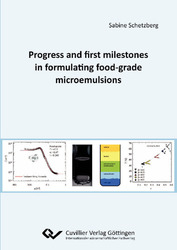| Departments | |
|---|---|
| Book Series (96) |
1378
|
| Nachhaltigkeit |
3
|
| Gesundheitswesen |
1
|
| Humanities |
2365
|
| Natural Sciences |
5406
|
| Mathematics | 229 |
| Informatics | 319 |
| Physics | 980 |
| Chemistry | 1363 |
| Geosciences | 131 |
| Human medicine | 243 |
| Stomatology | 10 |
| Veterinary medicine | 108 |
| Pharmacy | 147 |
| Biology | 835 |
| Biochemistry, molecular biology, gene technology | 121 |
| Biophysics | 25 |
| Domestic and nutritional science | 45 |
| Agricultural science | 1004 |
| Forest science | 201 |
| Horticultural science | 20 |
| Environmental research, ecology and landscape conservation | 148 |
| Engineering |
1793
|
| Common |
98
|
|
Leitlinien Unfallchirurgie
5. Auflage bestellen |
|
Advanced Search
Progress and first milestones in formulating food-grade microemulsions (English shop)
Sabine Schetzberg (Author)Preview
Table of Contents, Datei (24 KB)
Extract, Datei (43 KB)
In every day life the immiscibility of polar and non-polar components is a common problem. For instance molten chocolate coating already firms up, if it encounters the slightest bit of water. A smart possibility to overcome this problem is the use of microemulsions, which contain at least a polar, non-polar and an amphiphilic component. The formulation of bio compatible microemulsions is limited by the choice of surfactants permissible for applications in food, pharmaceutics and cosmetics. This work presents a progress and first milestones in formulating food-grade microemulsions which are suitable for all these applications. Triglycerides and phospholipids are edible, organic and thus the favored components. Microemulsions based on these were investigated. The first milestones towards the formulation of food-grade microemulsions are presented. Performed SANS measurements show, that microemulsions of the type H2O/NaCl – triglyceride – phospholipid – edible co-surfactant exhibit a bicontinuous structure. Systematic studies were performed on how these microemulsions can be tuned regarding temperature range, surfactant mass fraction and structure. Therefore, the influence of bio-compatible hydrophilic, hydrophobic and amphiphilic components on the phase behavior was investigated separately in well known (not food acceptable) model systems. Based on this work, a novel technique to introduce a polar into a non-polar phase and vice versa using a microemulsion or lamellar phase at low surfactant mass fractions was developed. This new invention of eXpandible moisture adapting sheets (X-mas) highlights the many possibilities of edible microemulsion for industrial exploitation.
| ISBN-13 (Printausgabe) | 3869556439 |
| ISBN-13 (Hard Copy) | 9783869556437 |
| ISBN-13 (eBook) | 9783736936430 |
| Language | English |
| Page Number | 246 |
| Edition | 1 Aufl. |
| Volume | 0 |
| Publication Place | Göttingen |
| Place of Dissertation | Universität Köln |
| Publication Date | 2011-02-14 |
| General Categorization | Dissertation |
| Departments |
Chemistry
Pharmacy |








